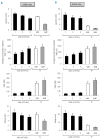Characterization of the thrombin generation potential of leukemic and solid tumor cells by calibrated automated thrombography
- PMID: 22419573
- PMCID: PMC3409814
- DOI: 10.3324/haematol.2011.055343
Characterization of the thrombin generation potential of leukemic and solid tumor cells by calibrated automated thrombography
Abstract
Background: Thrombin, the final enzyme of blood coagulation, is a multifunctional serine protease also involved in the progression of cancer. Tumor cells may activate blood coagulation proteases through the expression of procoagulant activities. However, specific information about the thrombin generation potential of malignant tissues is lacking. In this study we applied a single global coagulation test, the calibrated automated thrombogram assay, to characterize the specific procoagulant phenotypes of different tumor cells.
Design and methods: Malignant hematologic cells (i.e. NB4, HEL, and K562) or solid tumor cells (i.e. MCF-7 breast cancer and H69 small cell lung cells) were selected for the study. The calibrated automated thrombo-gram assay was performed in normal plasma and in plasma samples selectively deficient in factor VII, XII, IX or X, in the absence or presence of a specific anti-tissue factor antibody. Furthermore, cell tissue factor levels were characterized by measuring antigen, activity and mRNA expression.
Results: In normal plasma, NB4 induced the highest thrombin generation, followed by MCF-7, H69, HEL, and K562 cells. The anti-tissue factor antibody, as well as deficiencies of factors VII, IX and XII affected the thrombin generation potential of malignant cells to different degrees, allowing differentiation of the two different pathways of blood clotting activation - by tissue factor or contact activation. The thrombin generation capacity of NB4 and MCF-7 cells was tissue factor-dependent, as it was highly sensitive to inhibition by anti-tissue factor antibody and factor VII deficiency, while the thrombin generation capacity of H69, HEL and K562 was contact activation-dependent, as no thrombin was generated by these cells in factor XII-deficient plasma.
Conclusions: This study demonstrates that the calibrated automated thrombogram assay is capable of quantifying, characterizing, and comparing the thrombin generation capacity of different tumor cells. This provides a useful tool for understanding the key factors determining the global pro-coagulant profile of tumors, which is important for addressing specific targeted therapy for the prevention of thrombosis and for cancer.
Figures






References
-
- Wun T, White RH. Venous thromboembolism (VTE) in patients with cancer: epidemiology and risk factors. Cancer Invest. 2009;27(Suppl 1):63–74. - PubMed
-
- Rickles FR, Falanga A. Activation of clotting factors in cancer. Cancer Treat Res. 2009;148:31–41. - PubMed
-
- Falanga A, Rickles FR. Management of thrombohemorrhagic syndromes (THS) in hematologic malignancies. Hematology Am Soc Hematol Educ Program. 2007:165–71. - PubMed
-
- Falanga A, Panova-Noeva M, Russo L. Procoagulant mechanisms in tumour cells. Best Pract Res Clin Haematol. 2009;22(1):49–60. - PubMed
-
- Falanga A, Marchetti M, Vignoli A, Balducci D. Clotting mechanisms and cancer: implications in thrombus formation and tumor progression. Clin Adv Hematol Oncol. 2003;1(11):673–8. - PubMed
Publication types
MeSH terms
Substances
LinkOut - more resources
Full Text Sources

